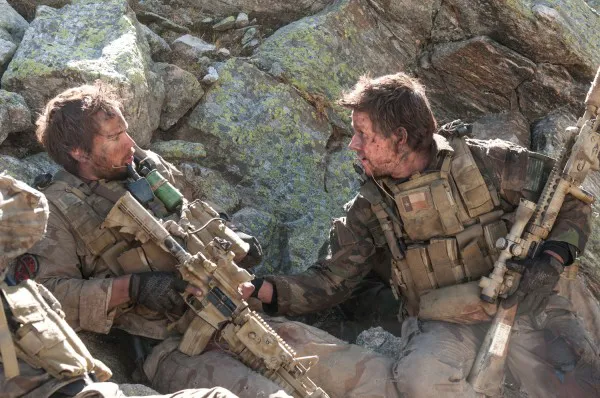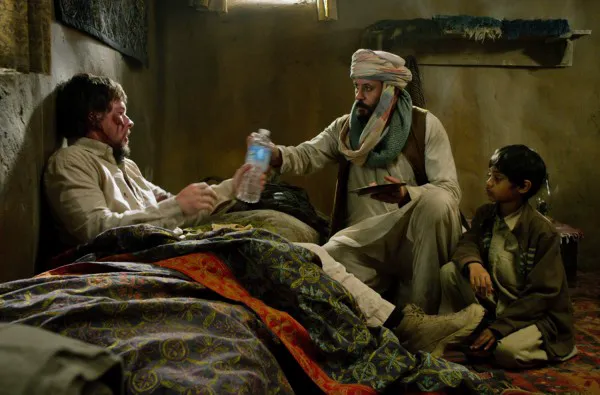Lone Survivor: A Patriotic Film with Unexpected Depth
Peter Berg’s new film doesn’t stray too far from the familiar American patriotic movie formula, but it offers some pleasant surprises for fans of the genre through certain approaches and techniques.
Intelligence reports reach an American base in Afghanistan about the discovery of a particularly dangerous Taliban commander. A squad of four Navy SEALs is sent behind enemy lines to eliminate the threat. As they approach the target location, they discover that instead of a dozen militants, Shah is guarded by a much larger army, making a firefight unavoidable. The four Americans, without communication or air support, engage in a battle that not all of them will survive.
The opening scenes of Peter Berg’s new film, director of “Hancock” and “Battleship,” showcasing the training of American Navy SEALs, instructors’ work against the backdrop of pompous speeches, and the ever-present Stars and Stripes in the background, might mislead the viewer. One might get the impression that this is just another patriotic propaganda piece, filled with lofty speeches about duty, homeland, and righteous violence. But don’t rush to leave the theater – “Lone Survivor,” while diligently fulfilling the mandatory program of military-patriotic cinema, is primarily interesting as a story about the failed Operation Red Wings.

The real “lone survivor,” Marcus Luttrell, makes a cameo appearance in one of the film’s opening scenes. He is the one who orders a recruit to clean up spilled coffee from the table.
The film is based on real events; moreover, the entire plot is recreated from the words of the “lone survivor” himself. It’s not a spoiler to reveal that the “lone survivor” is Marcus Luttrell, which Berg doesn’t hide, showing the rescued, wounded soldier at the very beginning of the film. Luttrell, who survived a real meat grinder in 2005, not only lived but also preserved the memory of his fallen comrades, immortalizing it first in his memoir and then by serving as a consultant on Peter Berg’s film. Let’s be honest, screenwriter and director Berg took certain “artistic liberties,” but overall, he maintained the framework of the confrontation between the Navy SEALs and the Taliban squad in a direction close to reality, even though it took him five long years from conception to realization.

To save on the film’s budget, Peter Berg took on the filming, setting himself the minimum wage allowed by the union. Mark Wahlberg and Taylor Kitsch followed his example.
Beyond Patriotism: A Different Approach to Heroes
But let’s return to patriotism. Military-patriotic cinema in America has been working flawlessly for many years – it consistently makes money, successfully promotes service in the armed forces, and flawlessly affects already patriotic Americans. So, what distinguishes “Lone Survivor” from other films in the genre? Perhaps only in the somewhat unusual approach to the characters. Unlike many other similar films (and his “Battleship,” by the way), Berg skips the stage of introducing the viewer to the heroes. Before the start of the battle, we know practically nothing about the soldiers, except for one detail from the life of Taylor Kitsch’s character; the key characters appear as “blank slates.” Is this a misunderstanding, a lack of skill on the part of the authors, or a deliberate move? Choose what’s closer to you – to empathize with a father, husband, or son with a known emotional foundation, or to form your own idea of the characters during the battle. During the battle, in the climactic scene of deciding whether to reveal themselves or sacrifice civilians for the sake of the operation, you will have plenty of opportunities to assess the actions of each character, compare them with your own worldview, and give your own assessment of what is happening. A controversial but interesting decision by the author, giving the opportunity not to passively observe the actions of a predictable set of stamped characters, but to take your own “battle” in uncharted territory.

A Gripping Action Film with Vulnerability
The film, of course, is far from deep philosophical films about the nature of war, the tempering and breaking of characters in conditions of risk to life, or the confrontation between violence and pacifism. First of all, “Lone Survivor” is a tough, driven action film, containing a captivating battle scene that stretches for almost half the film in the best traditions of “Black Hawk Down.” It also has breathtaking scenes, and moments in which it seems that your own heartbeat will give away the location of the camouflaged fighters, and there are colorful helicopter attacks and crashes (where would modern cinema be without an exploding helicopter?). However, this will not surprise fans of Peter Berg’s work; he has always been in complete order with action.
However, with all the abundance of action scenes, “Lone Survivor” is compelling because of its vulnerability. Berg’s soldiers are not immortal cyborgs, as heroes of action films are often shown. No, they make mistakes, they make wrong critical decisions, they suffer severe wounds and injuries, and they die, in the end. They die, but at the same time, they convey to the audience their thirst for life, their desire to survive, their desire to get home, finish an unfinished drawing, buy a horse for their bride, or become a hero of a feature film that people will look up to.